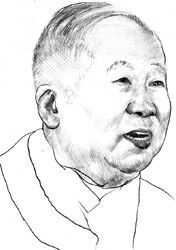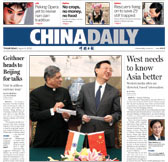

|
 Wu Liangyong [en.expo2010.cn] |
Wu Liangyong, born in 1922, is a member of the Chinese Academy of Sciences and Chinese Academy of Engineering and is a professor in the Department of Architecture at Tsinghua University. He has led many important projects, including the design of the new Beijing Library and the expansion of Tiananmen Square.
|
||||
The theme of World Expo 2010 Shanghai China is "Better City, Better Life." Linking beautiful cities with a beautiful life is a great manifesto that addresses the problems and hopes of our time.
The China Pavilion at this World Expo celebrates Chinese urban culture, whose depth has been recognized by scholars but not appreciated fully by the world at large. Comrade Li Changchun once suggested that the culture of China's settlements should be included as part of the country's traditional culture in a project called "China's Ancient Invention–Compass." Studies are still under way on the implementation of this suggestion. At this influential World Expo hosted by Shanghai in the early 21st century, the China Pavilion will promote the traditional culture of Chinese cities as well as their present-day achievements.
The theme of "Chinese Wisdom in Urban Development" underpins the exhibitions of the China Pavilion.
China's urban culture is as long and profound as its history. When we try to get to the core of its spiritual essence, we explore in some depth the following ideas:
1. The integration of cities and nature. Cities and nature are inseparable. Paintings depicting Chinese cities or landscapes always convey their poetic charms, a departure from the ancient Western methods of using aquatints to portray cities.
2. The integration of cities and villages. Traditionally, Chinese cities and villages comprise the integral heart of the nation. They work to the mutual benefit of each and coexist in harmony. As can be seen in Wang Ximeng's painting A Thousand Li of Rivers and Mountains, cities, villages, mountains, rivers and lakes all converge into one entity, a scene evoking special inspiration.
3. The link between cities and their various aspects, such as civilization, architecture, engineering, technology and transportation. Cities are home to colorful urban cultures that overlay the physical environment. For instance, the painting Along the River During the Qingming Festival vividly and accurately recorded the vibrant urban life and splendid image of a Chinese city in the 12th century.
4. The philosophical concept of harmony between man and nature and the ingeniousness of human endeavor. Examples of that include the Beijing-Hangzhou Grand Canal and the most representative urban sceneries in China.
The four preceding points probe a rich content drawn from real-life examples in literary and art works. They speak to the rich wisdom embodied in Chinese cities.
Maybe we have become so inured that we don't see these concepts clearly anymore. Today, however, we are using the platform of World Expo 2010 Shanghai China to renew their exploration and enrich our understanding of our cultural inheritance. We seek a grand rejuvenation of our Chinese civilization.
China has witnessed a far-reaching redevelopment of its cities since its founding 60 years ago and during the 30 years since the nation implemented policies of economic reform and opening to the outside world. Starting with our pioneering efforts in the Shenzhen Special Economic Zone, our progress has been stunning. These achievements may be summed up as follows:
First, regional development. China developed policies on regional development in as early as the 5th century BC, as recorded in "Yu Gong," the first Chinese classic on regional geography. In more modern times, regions such as the Yangtze River Delta, the Pearl River Delta, Beijing, Tianjin, Hebei and the Beibu Gulf have all enjoyed unparalleled development and made great strides in politics, the economy, science, technology and other fields, laying the foundation for their emergence as world-class metropolitan areas.
Second, insufficient attention to issues such as strains on urban ecological environments and the exploitation of rural assets. Today, however, there is a new awareness of these issues and innovative efforts are under way to address these issues. Campaigns to return cultivated land to forests and to protect natural scenic areas have been launched in recent years, greatly improving the prospects for the ecological environment in West China.
Third, learning lessons from the West. The Chinese nation has historically been adept at building on the experiences of others. We have opened our minds to adopt the best practices others have to offer and have made great strides in adapting those experiences to benefit our development.
Fourth, preserving our traditions. China treasures its culture, its history and its customs. We treat them as the integrated heart of our civilization and seek to harmonize the past with the present and the future.
However, there are pitfalls along the path. Lewis Mumford, a famous Western humanitarian scholar and an advocate of better urban living environments, questioned in the concluding paragraphs of his masterpiece "The City in History" whether urban development should be oriented toward cultural life or toward the promotion unfettered technological expansion. While believing the West is going further along the latter course, he cited the Chinese painting Along the River During the Qingming Festival as an example of the former path.
"The unique features of those various scenes, various professions, various cultural activities and various figures–these can produce unlimited combinations, permutations and variations," he wrote. "It is a city full of life instead of a perfect hive."
In trying to integrate China's ancient and modern achievements, we have placed our feet firmly on the path of harmony. We have endeavored to bend the use of science and technology to the greater good in the development of Chinese cities. The successful reconstruction of Tangshan and the development now under way in Wenchuan after the devastating earthquake in 2008 demonstrate our concern for the lives of people and their living standards. To ensure a better life for both urban and rural residents has been our guiding principle.


